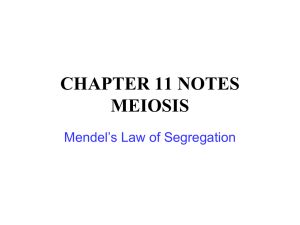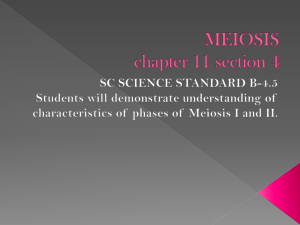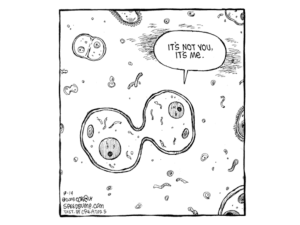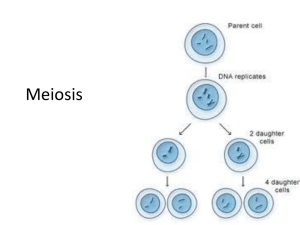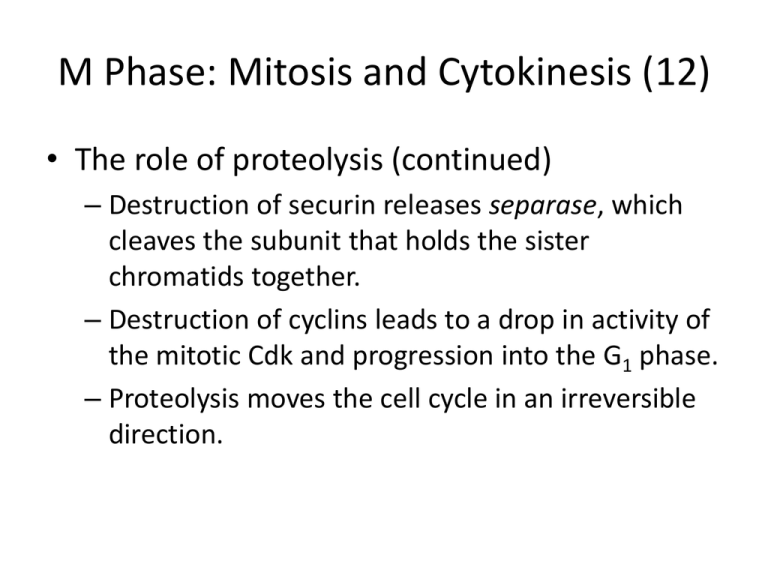
M Phase: Mitosis and Cytokinesis (12)
• The role of proteolysis (continued)
– Destruction of securin releases separase, which
cleaves the subunit that holds the sister
chromatids together.
– Destruction of cyclins leads to a drop in activity of
the mitotic Cdk and progression into the G1 phase.
– Proteolysis moves the cell cycle in an irreversible
direction.
Experimental demonstration of proteolysis in a
cell’s exit form mitosis
M Phase: Mitosis and Cytokinesis (13)
• The Events of Anaphase
– Chromosomes are split in synchrony.
– As chromosomes move toward a pole,
microtubules attached to kinetochores are
shortened.
– Movement of chromosomes toward the poles is
called anaphase A.
– Anaphase B is when the two spindle poles move
in opposite directions due to elongation of
microtubules.
The mitotic spindle and
chromosomes at anaphase
The mitotic spindle and
chromosomes at anaphase
M Phase: Mitosis and Cytokinesis (14)
• Forces Required for Chromosome Movements
at Anaphase
– Both dynein and kinesin are found at kinetochores
of chromosomes.
– Depolymerization of microtubules generates
sufficient force to move the chromosomes.
– In yeast, a protein is pushed by the force released
from depolymerization to help move the
chromosome toward the spindle pole.
Demonstration that microtubule depolymerization can
move attached chromosomes in vitro
Proposed mechanism for the movement of
chromosomes during anaphase
Proposed mechanism for the movement of
chromosomes during anaphase
M Phase: Mitosis and Cytokinesis (15)
• The Spindle Checkpoint
– The spindle checkpoint operates at the
metaphase/anaphase transition to check for
misaligned chromosomes.
– Unattached kinetochores contain a protein
complex that send a “wait” signal to prevent entry
into anaphase.
The spindle checkpoint
M Phase: Mitosis and Cytokinesis (16)
• Telophase
– During telophase, the daughter cells return to
interphase.
• Nuclear envelopes of the two nuclei are reassembled.
• Chromosomes become dispersed.
– The cytoplasm is partitioned into two cells.
Telophase
M Phase: Mitosis and Cytokinesis (17)
• Forces Required for Mitotic Movements
– Mitotic movement is powered by microtubule
motors (dynein and kinesin-related proteins).
• Microtubule motors are located at the spindle poles
and kinetochores.
• Motor proteins have a number of features:
– Keep the poles apart.
– Bring chromosomes to the metaphase plate and keep them
there.
– Elongate the spindle during anaphase B.
Proposed activity of
motor proteins during
mitosis
M Phase: Mitosis and Cytokinesis (18)
• Cytokinesis
– Cytokinesis in Animal Cells
• Starts with the indentation of the cell surface.
• The contractile ring theory suggested that a thin band
of actin and myosin filaments generates the force to
cleave the cell.
• The site of filament assembly (the plane of cytokinesis)
is determined by a signal coming from the spindle
poles.
Cytokinesis
The formation and operation of the
contractile ring during cytokinesis
Experimental demonstration of the importance
of myosin during cytokinesis
Experimental demonstration of the importance
of myosin during cytokinesis
Formation of the cleavage plane
M Phase: Mitosis and Cytokinesis (19)
• Cytokinesis in Plant Cells
– Formation of the cell plate, precursor to a new
cell wall.
– Cells build a cell membrane and cell wall in the cell
center.
– Cell plate begins with the appearance of the
phragmoplast, which then proceeds laterally.
– Material for the cell wall is brought to the
phragmoplast by Golgi vesicles.
The formation of the a cell plate
14.3 Meiosis (1)
• During meiosis, chromosome number is
halved and haploid cells are formed.
• Meiosis consists of two divisions.
– In the first division, homologous chromosomes
pair and then segregate ensuring that daughter
cells receive a full haploid set of chromosomes.
– In the second division, the two chromatids are
separated.
The stages of
meiosis
Meiosis (2)
• In different eukaryotes meiosis occurs at
different points in the life cycle.
– In gametic meiosis, the process is linked to
gamete formation.
– In zygotic meiosis, the process occurs after
fertilization. It occurs only in protists and fungi.
– In sporic meiosis, the process is independent of
gamete formation and fertilization.
A comparison of three
groups of organisms based
on the stage within the life
cycle when meiosis occurs
Meiosis (3)
• The Stages of Meiosis
– DNA is replicated prior to meiosis.
– Prophase I consists of several stages:
• In leptotene chromosomal condensation starts.
• During zygotene homologous chromosomes pair. This
process is called synapsis, and it is when homologues
associate via the synaptonemal complex.
• The synaptonemal complex allows interacting
chromatids to complete crossing-over.
• Synapsed chromosomes form a bivalent or tetrad.
The stages of prophase I
Association of the telomeres of meiotic
chromosomes with the nuclear envelope
The synaptonemal complex
Meiosis (4)
• Prophase I (continued)
– In pachytene synapsis ends.
– During diplotene the synaptonemal complex
disappears and homologous chromosomes start
moving apart.
• Chiasmata are the remaining points of attachment
between homologous chromosomes.
• Chiasmata occur where crossing over took place.
Visible evidence of crossing-over
Meiosis (5)
• Prophase I (continued)
– The final stage of prophase I is diakinesis, when
chromosomes are prepared for attachment to the
spindle fibers.
• Diakinesis ends with the disappearance of the
nucleolus and the disassembly of the nuclear envelope.
• Diakinesis is triggered by an increase in MPF activity.
Meiosis (6)
• Metaphase I
– The two homologous chromosomes are aligned at
the metaphase plate.
• Both chromatids of one chromosome face the same
pole.
• Homologous chromosomes are held by one or several
chiasmata.
• Absence of a chiasma can lead to abnormal segregation
of chrosomes.
Separation of homologous
chromosomes during meiosis I
Meiosis (7)
• Anaphase I
– Stage when homologous chromosomes separate.
• Maternal and paternal chromosomes of each tetrad
segregate into the two daughter cells independent of
other chromosomes.
• Behavior of chromosomes during anaphase I
corresponds to Mendel’s law of independent
assortment.
Meiosis (8)
• Telophase I
– Produces less dramatic changes than telophase of
mitosis.
– The nuclear envelope may or may not reform
during this stage.
– The stage between the two divisions is called
interkinesis.
• Cells during this stage have a haploid number of
chromosomes.
• Cells have a diploid amount of DNA.
Meiosis (9)
• Meiosis II
– It is simpler than meiosis I.
– During metaphase II, chromosomes are aligned so
that kinetochores of sister chromatids face
opposite poles.
– Sister chromatids separate during anaphase II.
– Meiosis II produces cells haploid in both amount
of DNA and chromosome number.
Meiosis (10)
• Genetic Recombination During Meiosis
– Meiosis increases genetic variability by mixing
maternal and paternal alleles between
homologous chromosomes.
– Recombination occurs by the physical breakage of
and ligation of individual DNA molecules.
• It occurs without the addition or loss of a single base
pair.
• DNA repair enzymes fill gaps that develop during the
exchange process.
Meiosis (11)
• Genetic recombination (continued)
– Prior to recombination, DNA strands are aligned
by homology search, in which homologous DNA
molecules associate with one another.
• Breaks are introduced into one strand of each duplex at
corresponding sites.
• The gap is subsequently widened.
• The two duplexes are joined to each other by Holliday
junctions (pairs of DNA crossovers).
Proposed mechanism
for genetic
recombination
initiated by doublestrand breaks
The Human Perspective: Meiotic Nondisjunction
and Its Consequences (1)
• Meiotic nondisjunction occurs when
homologous chromosomes do not separate
during meiosis I or sister chromatids do not
separate during meiosis II.
• Nondisjunction leads to the formation of
gametes and zygotes with abnormal number
of chromosomes, or aneuploidy.
Meiotic nondisjunction
The Human Perspective: Meiotic Nondisjunction
and Its Consequences (2)
• An extra chromosome
is referred to as a
trisomy.
– Down syndrome is the
resulty of trisomy of
chromosome 21.
• A missing chromosome
is referred to as a
monosomy.
The Human Perspective: Meiotic Nondisjunction
and Its Consequences (3)
• The presence of an abnormal chromosome
number is less disruptive to human
development.
– A zygote with only one X chromosome leads to
Turner syndrome, in which genitalia development
is arrested.
– A male with an extra X chromosome develops
Klinefelter syndrome, which leads to the presence
of secondary female sex characteristics.
The Human Perspective: Meiotic Nondisjunction
and Its Consequences (4)
• There is no precise answer as to why meiosis I
is more susceptible to nondisjunction than
meiosis II.
• A possibility is that sister chromatid cohesion
is not fully maintained over an extended
period thus allowing homologous
chromosomes to separate prematurely.
Experimental Pathways: The Discovery and
Characterization of MPF (1)
• MPF was first observed in studies of the effect of
cytoplasm on the state of the nucleus in oocytes.
Experimental Pathways: The Discovery and
Characterization of MPF (2)
• In developing
embryos, MPF
activity fluctuates
following the stages
of the cell cycle.
Experimental Pathways: The Discovery and
Characterization of MPF (3)
Experimental Pathways: The Discovery and
Characterization of MPF (4)
• Levels of cyclin were
found to correlate
with levels of MPF
activity.
• Purified MPF was
shown to have
kinase activity and
stimulate nuclei to
prepare for entry
into mitosis.

